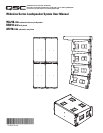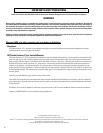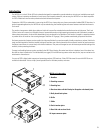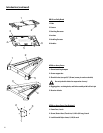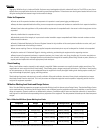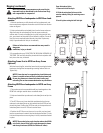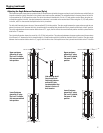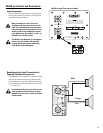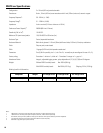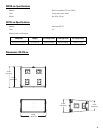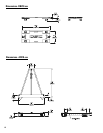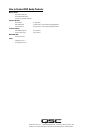
5
Rigging
Rigging the WideLine Array is simple and flexible. Enclosures are pinned together with quick-release ball-lock pins. The AF218-sw array frame
supports flown array applications and can be inverted for ground stack applications. The enclosures can also be ground stacked without a frame
using the stacking feet and recesses integral to the enclosure’s design.
Rules for Suspension
•Correct use of all suspension hardware and components is imperative in sound system rigging and deployment.
•Always calculate suspended loads before lifting to ensure suspension components and hardware are used within their respective load limits.
•Research local codes and regulations to fully understand the requirements for suspended loads in the venue in which the equipment is to be
suspended.
•Use only shackle holes for suspension of array.
•Be absolutely certain of the integrity of any structural member intended to support suspended loads. Hidden structural members can have
hidden structural weakness.
•Consult a Professional Mechanical or Structural Engineer licensed in the jurisdiction of the sound system installation to review, verify, and
approve all attachments to the building or structure.
•Never assume anything- Owner or third-party supplied suspension attachment points may not be adequate for the loads to be suspended.
•Employ the services of a Professional Rigger for hoisting, positioning, and attaching the equipment to the supporting structure.
•Always inspect all components (enclosures, suspension brackets, pins, frames, bolts, nuts, slings, shackles, etc.) for cracks, wear, deforma-
tion, corrosion, missing, loose, or damaged parts that could reduce the strength of the assembly before lifting. Discard any worn, defective, or
suspect parts and replace them with new appropriately load-rated parts.
Shock Loading
When a load is either moved or stopped, its static weight is magnified. Sudden movements can magnify the static weight several times. This
magnification of static weight is termed "shock loading". Shock loading poses a danger to equipment and workers. The effects of shock loading
can be instantaneous, or they may remain undetected unless the equipment is visually damaged. Avoiding shock loading requires careful plan-
ning and knowledge of equipment, rigging, and lifting practices.
Shock loading of equipment and structures is usually confined to lifting and installation, but natural forces (winds, earthquakes) can impose
shock loads several times the static load. This is why structures and suspension equipment must be capable of supporting several times the
weight of the equipment suspended.
WideLine Working Load Limits and Design Factors
Table 1 lists the WideLine suspension components and provides Working Load Limit data at various Design Factors. The tabulated Design Factors
are for static loads only. The choice of which Design Factor to use will depend upon the jurisdiction and venue of installation, as well as the con-
ditions of suspension. Dynamic conditions are determined by unknown, installation-specific factors and should be referred to a Licensed Struc-
tural Engineer for clarification before proceeding with any suspension of the equipment. The data presented is based upon the listed component
weights:
1- Working Load Limits are per fastener loaded in double shear. Data is for informational purposes only.
Table 1: WideLine WL218-sw System Working Load Limits
Component Weight 5:1 Design Factor 7:1 Design Factor 10:1 Design Factor
WL218-sw Loudspeaker 206 lb (93.4 kg) 3400 lb(1540 kg) 2400 lb (1090 kg) 1700 lb (771 kg)
AF218-sw Array Frame 80 lb (36.3 kg) 3400 lb(1540 kg) 2400 lb (1090 kg) 1700 lb (771 kg)
1/2-inch Shoulder Bolt
1
n/a 6400 lb (2900 kg) 4500 lb (2040 kg) 3200 lb (1450 kg)
5/16-inch Ball Lock Pin
1
n/a 2400 lb (1090 kg) 1700 lb (771 kg) 1200 lb (544 kg)
1/2-inch Ball Lock Pin
1
n/a 6400 lb (2900 kg) 4500 lb (2040 kg) 3200 lb (1450 kg)



